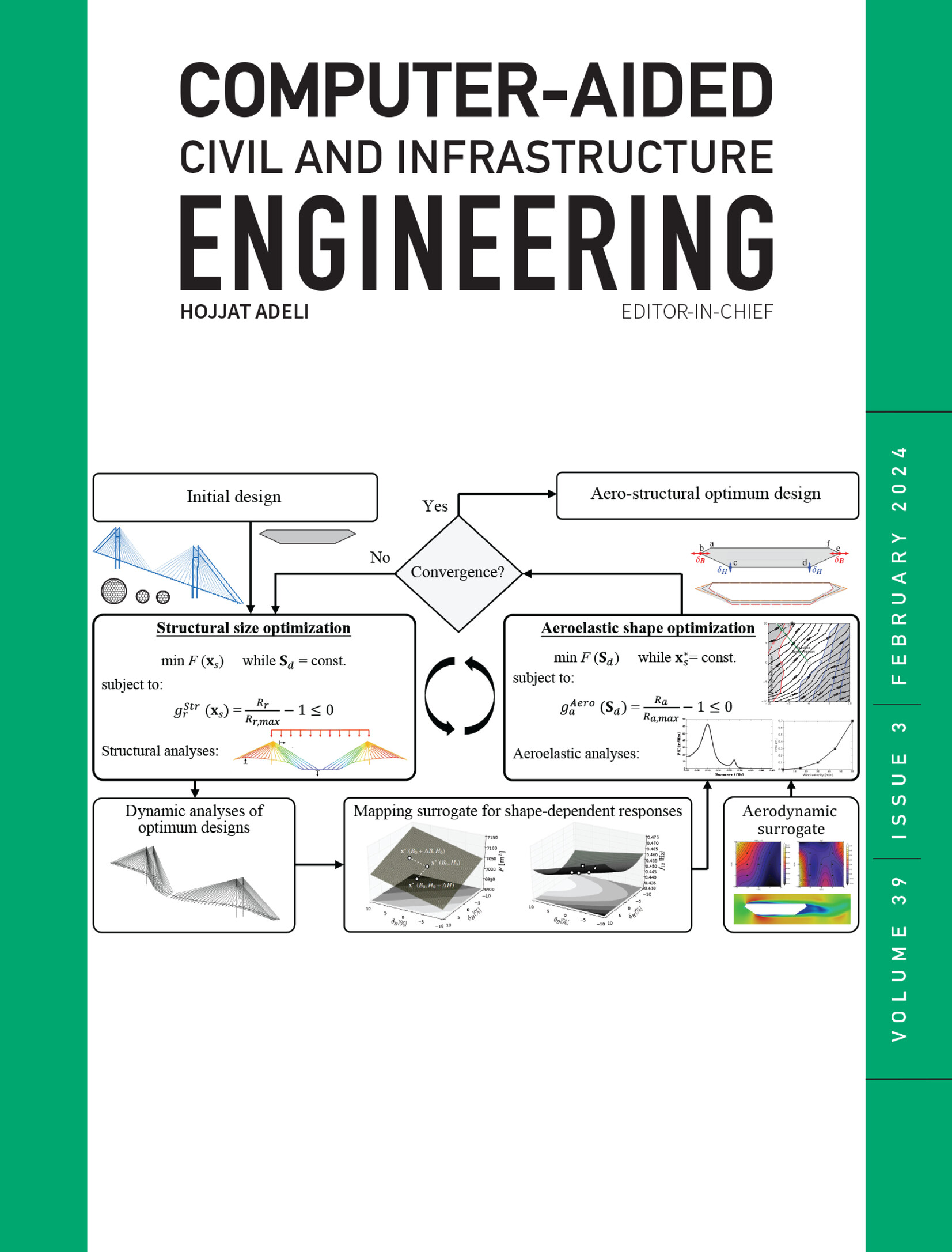用于识别桥梁车辆荷载的低复杂度实时检测变压器
IF 9.1
1区 工程技术
Q1 COMPUTER SCIENCE, INTERDISCIPLINARY APPLICATIONS
引用次数: 0
摘要
车辆荷载识别(VLI)是桥梁健康监测、安全评估和智能维修的关键。然而,基于计算机视觉的VLI面临着两个关键挑战,即动态场景下识别精度的降低和边缘监控设备施加的计算限制。为此,开发了一种低复杂度的实时检测变压器(LC - RTDETR),以建立桥式VLI的框架。所提出的LC - RTDETR为VLI提供了基础感知,并具有三个优势:(1)通过星型网络骨干进行轻量级特征提取,(2)通过动态范围直方图自关注模块实现单尺度融合的鲁棒特征表示,以及(3)通过所提出的上下文引导的空间特征重建金字塔网络提高多尺度处理效率。这种架构增强了复杂场景中的准确性,同时减少了计算需求。对于连续轨迹采集,所提出的LC - RTDETR检测被用于BoT - SORT跟踪,该跟踪结合了桥特定的相机运动估计和两级身份关联。通过双边界盒定位实现精确的车辆定位,其中实现了车身悬架误差最小化和方向矢量更新。实验结果表明,LC - RTDETR比RTDETR每秒帧数高9.8%,参数减少48.2%,浮点运算减少65.4%。实际验证证实了对光照变化、遮挡、运动模糊和恶劣天气的鲁棒性,同时在变道机动和速度波动期间准确捕获稳定的轨迹,从而实现车辆定位。最后,有效的重量-位置匹配完全集成在框架内。本文章由计算机程序翻译,如有差异,请以英文原文为准。
Low‐complexity real‐time detection Transformer for identifying bridge vehicle loads
Vehicle load identification (VLI) is pivotal for bridge health monitoring, safety assessment, and intelligent maintenance. However, computer vision‐based VLI is confronted by two critical challenges, that is, compromised identification accuracy under dynamic scene and computational constraints imposed by edge monitoring devices. To this end, a low‐complexity real‐time detection Transformer (LC‐RTDETR) is developed to establish a framework for bridge VLI. The proposed LC‐RTDETR provides foundational perception for VLI and features three advantages: (1) lightweight feature extraction via the star network backbone, (2) robust feature representation enabled by the dynamic‐range histogram self‐attention module for single‐scale fusion, and (3) enhanced multi‐scale processing efficiency through the proposed context‐guided spatial feature reconstruction pyramid network. This architecture augments accuracy in complex scenes while reducing computational demands. For continuous trajectory acquisition, detections from the proposed LC‐RTDETR are utilized by BoT‐SORT tracking, which incorporates bridge‐specific camera motion estimation and two‐stage identity association. Precise vehicle positioning is achieved through dual‐bounding‐box localization, in which body‐suspension error minimization and orientation vector updating are implemented. Experimentally, LC‐RTDETR outperforms RTDETR with a 9.8% higher frames per second, 48.2% fewer parameters, and 65.4% lower floating‐point operations. Practical validation confirms robustness to illumination changes, occlusion, motion blur, and adverse weather while accurately capturing stable trajectory during lane‐changing maneuvers and speed fluctuations to enable vehicle localization. Finally, effective weight‐position matching is fully integrated within the framework.
求助全文
通过发布文献求助,成功后即可免费获取论文全文。
去求助
来源期刊
CiteScore
17.60
自引率
19.80%
发文量
146
审稿时长
1 months
期刊介绍:
Computer-Aided Civil and Infrastructure Engineering stands as a scholarly, peer-reviewed archival journal, serving as a vital link between advancements in computer technology and civil and infrastructure engineering. The journal serves as a distinctive platform for the publication of original articles, spotlighting novel computational techniques and inventive applications of computers. Specifically, it concentrates on recent progress in computer and information technologies, fostering the development and application of emerging computing paradigms.
Encompassing a broad scope, the journal addresses bridge, construction, environmental, highway, geotechnical, structural, transportation, and water resources engineering. It extends its reach to the management of infrastructure systems, covering domains such as highways, bridges, pavements, airports, and utilities. The journal delves into areas like artificial intelligence, cognitive modeling, concurrent engineering, database management, distributed computing, evolutionary computing, fuzzy logic, genetic algorithms, geometric modeling, internet-based technologies, knowledge discovery and engineering, machine learning, mobile computing, multimedia technologies, networking, neural network computing, optimization and search, parallel processing, robotics, smart structures, software engineering, virtual reality, and visualization techniques.

 求助内容:
求助内容: 应助结果提醒方式:
应助结果提醒方式:


